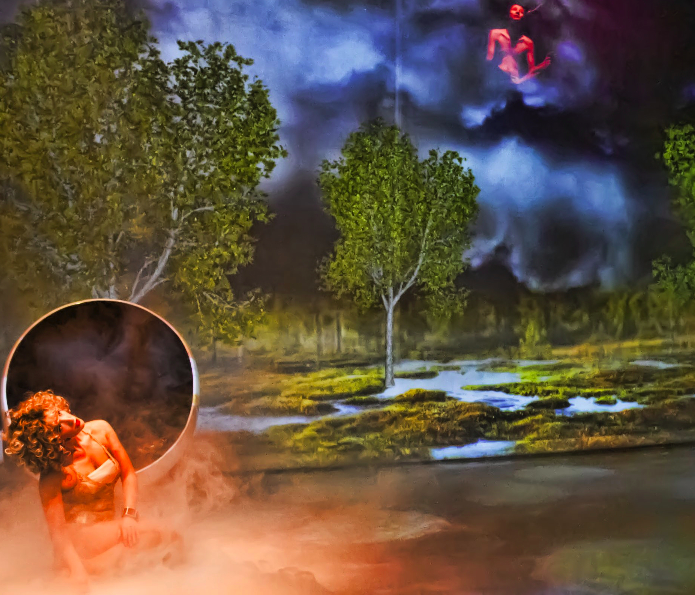
“Barbarella or What We Talk About When We Talk About Love” at Von Krahl Theatre.
Director: Peeter Jalakas.
Dramaturges: Taavi Eelmaa, Peeter Jalakas, Tarmo Jüristo.
Costume design: Reet Aus.
Technical solutions: Enar Tarmo.
Video design: Mikk-Mait Kivi.
Composers: Jakob Juhkam, Ott Kartau and troupe.
Choreography: Arolin Raudva.
Light Design: Oliver Kulpsoo.
A little bit of context. Jean-Claude Forest’s “Barbarella” was first published in an erotic publication V-Magazine in 1962. The editor-in-chief asked Forest to create some sort of female version of Tarzan – Tarzella – but Forest wasn’t interested in this. Instead he created an 8-part saga about the adventures of the space queen Barbarella in the 41st century.
In 1964 the separate comic strips were gathered together into a more wholesome work, marketed as the first comics aimed at adults[1]. Unexpectedly even to the author Barbarella became a cultural phenomenon, preceding only slightly the sexual revolution, introducing the first popular sexually liberal sci-fi heroine into the tradition of comics.
In 1968, a year after the notorious Summer of Love in San Francisco (and elsewhere), the film adaptation of Barbarella by De Laurentiis/Vadim/Fonda – where Forest acted as consultant – fit in nicely with other films of this kind[2]. The pendulum of history had shifted into a different extreme from the era of Victorian priggishness a hundred years earlier. And Barbarella was one of the cultural fore and side products of this paradigmatic transformation.
Barbarella has a different influence today. The kitsch and retro aesthetics, projected onto the screened walls on the side of the stage – there are basically no set decorations – has a curious and refreshing air to it. The sexy space queen in her hairy pinkish purple space ship makes an emergency landing into a quiet, tense and dimming living room, which has just seen the exchange of fishy views on love and a bottle of gin, and enthusiastically sighs out the greeting: “Love!”
The story begins like it does in the film version: The President of the Universe gives Barbarella the task of finding the scientist Duran Duran[3]. The task is of utmost importance – galactic peace is on the line. What follows is a cosmic journey from one weird planet to another, in the course of which the astronavigatrix drifts from her set course, meeting an eclectic selection of characters with varying levels of sexual repression and often finding herself in humorous situations because of her naivety.
This light-hearted saga is veiled and in a way tied together in its own way by Raymond Carver’s short story “What We Talk About When We Talk About Love”[4], which opens and closes the performance and adds a more reflective and even pessimistic tone to Barbarella. Neither text claims to hold any answers as to what we are really talking about when we are talking about love. On the contrary, the viewer is left in the dark with their own thoughts. I remembered an interview with Tõnu Õnnepalu I read in Müürileht – who also happened to be sitting in the audience – where he mentioned that in our days love is a “hugely overburdened notion and yearning”; people are searching for everything, but find little and lose hope.[5] It is probably the legacy of all those romantically inclined pencil-pushers suffering from the pangs of love why people take it so seriously. Although the performance didn’t directly resort to generalisations, then perhaps it was like an anachronistically clad nod to point out that – things can be simpler.
[2] Terry Southern, who worked on the script of “Barbarella” went on to write “Easy Rider” next (1969; produced and co-written by Jane Fonda’s brother Peter who also starred in it. Small Hollywood). 1968 also saw the release of “Candy”, based on Southern’s novel of 1958, where a naive blonde woman Candy finds herself again and again, with different characters, in different sexual farces; in this case an analogous narrative as well as one of the peculiar phases in Marlon Brando’s career (https://www.youtube.com/watch?v=XghPOP2b9mw).
[3] Initially bearing the more French version Durand-Durand. This is also where the British rock collective Duran Duran got its name from.
[4] From a collection of short stories of the same name (first published in 1981)
[5] https://www.muurileht.ee/kohaloleku-kunst-intervjuu-tonu-onnepaluga/
